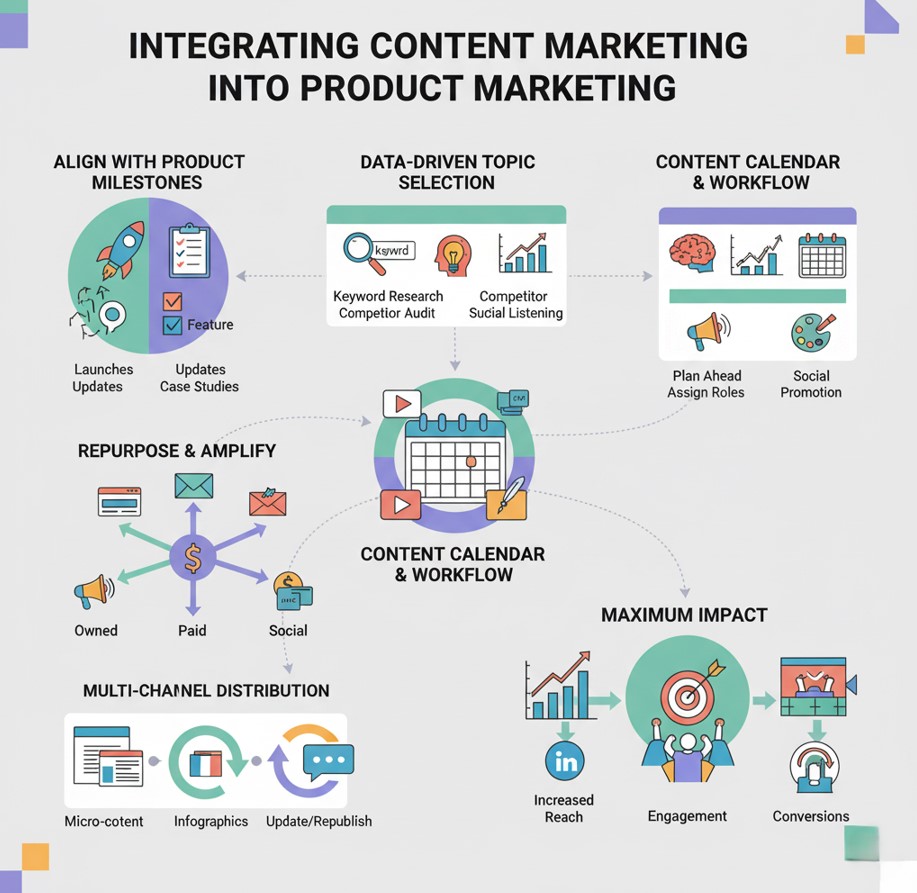In the world of product marketing, building authority and driving demand are two sides of the same coin. Product Marketers need more than just great products—they need their voices heard, their brands trusted, and their pipelines steadily filled. Content Marketing serves as one of the most effective ways to achieve both. It helps establish credibility, educate customers, and create a pull that complements traditional push tactics.
This guide walks you through how Product Marketers can use content marketing to build authority and generate demand. We’ll cover strategy, execution, measurement, and scaling so you can design a content program that does more than just talk—it converts.
Why Authority & Demand Matter in Content Marketing
Before diving into the how, it’s important to understand why authority and demand are essential, especially for Product Marketers.
-
Credibility and trust: In many markets, customers research deeply before purchasing. If your content demonstrates expertise, insight, and genuine understanding, you become a known quantity. That trust pays off in shorter sales cycles and higher conversions.
-
Differentiation: Products can be copied, features can be matched, but a voice, perspective, tone, and content that reflects your brand’s unique experience is harder to replicate.
-
Demand generation: Authority builds awareness. Awareness generates interest. Interest, when nurtured, results in leads.
-
Content is evergreen: Good content marketing can continue delivering traffic, leads, and authority long after publication.
For Product Marketers, content marketing is not a “nice to have”—it’s central to your product marketing strategy.
Key Foundations: Getting Started Right
Before producing content, set a strong foundation. This ensures your efforts build authority and demand in alignment, and aren’t wasted.
-
Know Your Audience Deeply
-
Develop buyer personas. Understand their role, challenges, purchase triggers, and objections.
-
Map out customer journey stages—awareness, consideration, decision—so you know what content is needed at each stage.
-
Use qualitative data (interviews, feedback, support tickets) plus quantitative data (analytics, surveys) to understand what questions your audience has, what search terms they use, and where they hang out.
-
-
Define Clear Goals for Content Marketing
-
Are you aiming to build authority (brand recognition, trust)? Or directly to drive demand (leads, signups, purchases)? Often both, but being clear helps with content types, tone, and measurement.
-
Use SMART goals: e.g. increase organic traffic by X% in Y months, generate Z qualified leads per month via content, improve conversion rate of content‑to‑trial by X%.
-
-
Audit Existing Content & Gaps
-
What content do you already have? What’s performing well? What’s outdated?
-
Where are the gaps in terms of topic, funnel stage, and format?
-
What are competitors producing? What content do customers expect but seem not to find?
-
-
Build Positioning & Messaging that Supports Authority
-
Define what makes your product or brand different.
-
What unique insights or expertise do you have? What data, stories, and case studies can you present?
-
Establish voice, tone, and style guidelines so your brand comes across consistently.
-
Content Types & Formats for Authority
To build authority, you need content that educates, informs, inspires—not just sells. Here are formats that Product Marketers should consider:
-
Thought leadership content (essays, opinion pieces, trend reports): Share your vision of the future in your domain; show you’re thinking ahead.
-
In‑depth guides, whitepapers, and ebooks: Become a go‑to resource. Dive deeply into topics your audience cares about.
-
Case studies and customer stories: Social proof is essential. Show real people using your product, results, and the journey.
-
Webinars, workshops, virtual events: Live content builds a connection. Q&A builds trust.
-
Interactive content: Quizzes, calculators, assessments. These often perform well because they engage users.
-
Videos & podcasts: Especially when you can interview customers, subject matter experts, or provide demos.
-
Blogging and SEO content: Useful for the awareness stage. Answer questions people are Googling. Each post should be tailored to help your audience.
Content That Drives Demand
Authority is important, but if you don’t convert, it won’t help your business. Demand‑oriented content complements authority‑building content. Here’s how:
-
Comparison content: Product vs alternatives, upsides/downsides. Helps people in the consideration stage.
-
Demo videos/walkthroughs: Let prospects see the product in action.
-
Free trial/sample content prompts: E.g., “Download this template,” “Try our product free,” “See a demo”.
-
Landing pages optimized for conversion: Clear messaging, social proof, strong CTAs.
-
Email nurture sequences: Once you attract leads via content, nurture them with content that aligns with their needs and their stage in buyer journey.
-
FAQ / objection‑handling content: Address typical buyer concerns via blog posts, videos, or dedicated sections.
Strategy: Integrating Content Marketing into Product Marketing

Here’s how Product Marketers can weave content marketing into the product marketing strategy for maximum impact.
-
Align Content with Product Milestones
-
Use product launches, updates, and feature releases as opportunities for content (“what’s new,” “how to use,” “behind the scenes”).
-
Collect data during development or beta programs to feed into content (case studies, lessons learned, comparisons).
-
-
Data‑Driven Topic Selection
-
Use search keyword research, competitor content audits, and forum/community / social listening to find what people are really asking.
-
Let data, not assumptions, guide content calendar.
-
-
Set Up a Content Calendar & Workflow
-
Plan ahead: blog posts, webinars, content upgrades, video, etc.
-
Assign roles (writers, editors, designers, reviewers).
-
Include promotion/distribution as part of planning.
-
-
Multi‑Channel Distribution
-
Owned channels: website, blog, email newsletter.
-
Earned channels: guest posts, influencer contributions, media coverage.
-
Paid channels: promoted content, social ads, and display.
-
Social media sharing: tailor content format per platform.
-
-
Repurpose & Amplify
-
Turn long‑form content into micro‑content (infographics, social posts, quotes).
-
Republish, update content periodically.
-
Translate content for different formats/channels.
-
Measurement: Authority & Demand Metrics
To know whether your content marketing is working, you need to measure both authority and demand.
| What to Measure (Authority) | What to Measure (Demand / Conversion) |
|---|---|
| Brand mentions, media/influencer references | Leads generated from content channels |
| Organic traffic & search rankings for key authority topics | Conversion rates on content‑led landing pages |
| Engagement metrics: time on page, bounce rate, comments/shares | Email open/click rates, demo/trial requests |
| Followers, newsletter subscriptions | Churn or onboarding success (for retained customers) |
| Backlinks & technical SEO metrics | Cost per lead, Customer Acquisition Cost (CAC) for leads coming from content |
Also, set up attribution models if possible, so you can see which content helped move people down the funnel—not just what content they saw first.
Challenges & How to Overcome Them
While content marketing offers a huge upside, it’s not without challenges, especially for Product Marketers.
-
Resource constraints: quality content takes time and money. Overcome by prioritizing high‑impact content and repurposing.
-
Maintaining consistency: Many efforts falter because the content is irregular. Build workflows & content calendars to keep cadence.
-
Signal vs noise: It’s easy to produce content, but harder to produce useful content that helps your audience. Always focus on value (address real problems, questions, needs).
-
Standing out in saturated spaces: If competitors are writing about the same topics, find new angles—case studies, unique data, formats, niche topics.
-
Balancing authority vs promotion: Too much promotion turns audiences off. Authority content must deliver value first. Demand content should be timed and relevant.
Scaling & Optimizing
As your content gains traction, you’ll want to scale without diluting quality.
-
Create Templates & Playbooks: For recurring content types (case studies, webinars, guides), define templates and best practices.
-
Delegate & collaborate: Use internal subject matter experts, hire freelancers, or agencies for specialized content like video or technical writing.
-
Use tools & automation: Tools for SEO suggestions, content calendars, editorial tools, email automation, analytics dashboards, and social scheduling.
-
A/B test content, formats, headlines: Small tests to discover what works best for your audience.
-
Update & refresh content: Old content that still gets traffic can often be updated (new data, visuals, better SEO) for renewed performance.
Putting It into Practice: Example Workflow
Here’s how a Product Marketer might set up a quarterly content marketing plan aimed at authority + demand:
| Week | Activity |
|---|---|
| Week 1 | Audit past content, identify gaps; perform keyword and audience research; define objectives & metrics. |
| Week 2 | Plan content calendar: 1 long‑form guide (authority), 2 blog posts (awareness), 1 webinar (engagement), 1 case study (demand) + social amplification. |
| Week 3 | Create long‑form guide, design assets, schedule promotion strategy; prepare webinar. |
| Week 4 | Publish & promote content; run webinar; perform follow‑up; collect leads. |
| Weeks 5‑6 | Analyze metrics: traffic, engagement, leads. Gather feedback. Adjust the content calendar for next month based on what’s working. |
FAQs (Frequently Asked Questions)
Q1: What is the difference between authority content and demand content?
Authority content aims to build trust, thought leadership, and expertise (e.g. industry insights, trend reports, guides). Demand content is focused on generating leads or sales (e.g. demos, product comparisons, free trials).
Q2: How long does content marketing take to build authority?
It depends on consistency, quality, and niche. For many brands, visible authority gains take 6‑12 months, especially for SEO and organic reach.
Q3: What content channels are best for Product Marketers?
Channels that work well include blogs, webinars, case studies, email newsletters, podcasts, social media (especially LinkedIn or industry forums), and guest content on respected industry sites.
Q4: How do I ensure content doesn’t come off as too promotional?
Focus on helping the audience: solve their problems, give useful info, be transparent. Blend educational/helpful content with product content. Use soft CTAs rather than pushing hard all the time.
Q5: How often should I update older content?
Check content performance every few months. If older posts are still getting traffic, update with fresh data, newer insights, better visuals, or improved SEO. Aim to refresh high‐value content quarterly or semi‑annually.
Q6: What tools help with content marketing for product marketers?
Tools for keyword research (Ahrefs, SEMrush), content planning (Trello, Asana, Notion), SEO optimization (Yoast, SurferSEO), analytics (Google Analytics, dashboards), email & automation platforms (Mailchimp, HubSpot), webinar tools, design tools (Canva, Figma).
Conclusion
For Product Marketers, Content Marketing isn’t just a tactic—it’s a cornerstone of building authority and driving demand. When done strategically, content does double duty: It elevates your brand in the minds of prospects (authority) and encourages them into meaningful action (demand).
Start with strong audience insight and clear goals. Mix in different content types, align content with the buyer journey, distribute smartly, measure well, and keep iterating. With patience and consistency, your content marketing will become a growth engine—one that compounds over time.
Learn more about: How AI Is Changing the Future of Product Marketing





